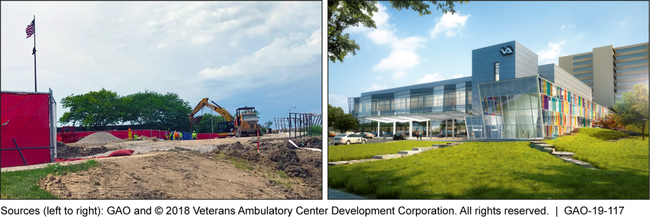VA Construction: Strengthened Pilot Design and a Dedicated Team Could Improve Real-Property Donation Pilot Program
Fast Facts
A 2016 law allows a VA pilot program to accept donations for facility construction or improvements. In Omaha, Nebraska, one donor group—in consultation with the VA—is building an ambulatory care center. The VA and the donor group said this project is proceeding faster and at a lower cost than a typical VA project. However, VA officials said it is hard to find partners to make large donations.
We made 3 recommendations, including ways to make the program's steering committee more effective at finding partners.
A Rendering of the Omaha (NE) Veterans Affairs Ambulatory Care Center Currently Under Construction

This image shows a rendering of the completed facility.
Highlights
What GAO Found
The Department of Veterans Affairs (VA) is conducting a pilot program, called CHIP-IN, that allows VA to partner with non-federal entities and accept real property donations from them as a way to help address VA's infrastructure needs. Although VA signed its first project agreement under the program in April 2017, VA has not yet established a framework for effective design of the pilot program. Specifically, VA's pilot program design is not aligned with four of five leading practices for designing a well-developed and documented pilot program. VA has begun to implement one leading practice by improving its efforts to communicate with relevant stakeholders, such as including external stakeholders in key meetings. However, the VA offices involved have not agreed upon and documented clear, measurable objectives for the pilot program, which is a leading practice. Further, VA has not developed an assessment methodology or an evaluation plan that would help inform decisions about whether or how the pilot approach could be expanded. While VA officials said they intend to develop these items as tasks for the newly formed CHIP-IN steering committee, they have no timeline for doing so. Without clear objectives and assessment and evaluation plans, VA and Congress may have difficulty determining whether the pilot approach is an effective way to help address VA's infrastructure needs.
To date, the CHIP-IN pilot suggests that donation partnerships could improve construction projects, but identifying donors and establishing a team for the pilot program have presented challenges. Officials from VA and the donor group for the first pilot project—an ambulatory care center in Omaha, Nebraska—said they are completing the project faster than if it had been a standard federal construction project, while achieving potential cost savings by using private sector practices. However, VA officials said it is challenging to find partners to make large donations with no financial return, and VA's lack of marketing and philanthropic development experience exacerbates that challenge. VA and the donor group agreed that a dedicated team of individuals with relevant expertise could facilitate the pilot's implementation. The new CHIP-IN steering committee could serve this purpose, but it lacks documented roles and responsibilities. Establishing a team with clear roles and responsibilities and identifying both available and needed staff resources could assist VA in partnering with additional donors and creating new opportunities to meet veterans' needs.
Department of Veterans Affairs' Ambulatory Care Center in Omaha, NE—Construction Site and Rendering of the Completed Facility

Why GAO Did This Study
VA has pressing infrastructure needs. The Communities Helping Invest through Property and Improvements Needed for Veterans Act of 2016 (CHIP-IN Act) authorized VA to accept donated real property—such as buildings or facility construction or improvements—through a pilot program. VA has initiated one project in Omaha, Nebraska, through a partnership with a donor group. VA can accept up to five donations through the pilot program, which is authorized through 2021.
The CHIP-IN Act includes a provision for GAO to report on donation agreements. This report (1) examines the extent to which the VA's pilot design aligns with leading practices and (2) discusses what VA has learned from the pilot to date. GAO reviewed VA documents, including plans for the pilot program, and visited the Omaha pilot project. GAO interviewed VA officials, the Omaha donor group, and three non-federal entities that responded to VA's request seeking donors. GAO compared implementation of VA's pilot to leading practices for pilot design, organizational transformation, and cross-functional teams.
Recommendations
GAO is recommending that VA: (1) establish pilot program objectives, (2) develop an assessment methodology and an evaluation plan, and (3) document roles and responsibilities and identify available and needed staff resources. VA concurred with GAO's recommendations.
Recommendations for Executive Action
| Agency Affected | Recommendation | Status |
|---|---|---|
| Department of Veterans Affairs | The Secretary of VA should ensure that internal stakeholders--such as the Communities Helping Invest through Property and Improvements Needed for Veterans (CHIP-IN) steering committee's members--agree to and document clear, measurable objectives for the CHIP-IN pilot that will help inform decisions about whether and how to scale the program. (Recommendation 1) | In December 2016, Congress enacted the Communities Helping Invest through Property and Improvements Needed for Veterans Act of 2016 (CHIP-IN Act), authorizing the Veterans Administration (VA) to partner with non-federal entities and accept donated real property from them--such as buildings or facility construction or improvements--through a pilot program. VA has initiated one pilot project in Omaha, Nebraska, through a partnership with a donor group. While several VA offices have been involved in the pilot program, a steering committee was created to implement the CHIP-IN Act. In 2018, GAO reported that the VA offices involved had not agreed upon and documented clear, measurable... objectives for the pilot program, which is one of the five leading practices for designing a well-developed and documented pilot program. Without clear, measurable objectives, VA would be unable to implement other leading practices for pilot design, such as determining how to make decisions about scalability. Further, not defining objectives in the near future would ultimately affect VA's ability to evaluate the pilot and provide information to Congress about its results. Therefore, GAO recommended that VA should ensure that internal stakeholders--such as the steering committee members--agree to and document clear, measurable objectives for the CHIP-IN pilot that will help inform decisions about whether and how to scale the program. In 2019, GAO confirmed that the steering committee has since developed and agreed to five pilot program objectives that are documented, clear, and measurable. These objectives will help VA to (1) implement other leading practices for pilot design, (2) assess the scalability of the pilot, and (3) inform the agency or Congress' decisions on whether and how to implement a new approach in a broader context--or in other words, whether the pilot can be increased in size to a larger number of projects over the long term, or how well lessons learned can be incorporated into broader efforts.
View More |
| Department of Veterans Affairs | The Secretary of VA should ensure that internal stakeholders--such as the CHIP-IN steering committee's members--develop an assessment methodology and an evaluation plan that are linked to objectives for the CHIP-IN pilot and that help inform decisions about whether and how to scale the program. (Recommendation 2) | In December 2016, Congress enacted the Communities Helping Invest through Property and Improvements Needed for Veterans Act of 2016 (CHIP-IN Act), authorizing the Department of Veterans Affairs (VA) to partner with non-federal entities and accept donated real property from them--such as buildings or facility construction or improvements--through a pilot program as a way to help address VA's infrastructure needs. VA had initiated one pilot project in Omaha, Nebraska, through a partnership with a donor group. Several VA offices have been involved in the pilot program, and a steering committee was created to implement the CHIP-IN Act. In 2018 GAO reported that VA had not yet fully developed...
|
| Department of Veterans Affairs | The Secretary of VA should ensure that the CHIP-IN steering committee documents the roles and responsibilities of its members and identifies available staff resources, including any additional expertise and skills that are needed to implement the CHIP-IN pilot program. (Recommendation 3) | In December 2016, Congress enacted the Communities Helping Invest through Property and Improvements Needed for Veterans Act of 2016 (CHIP-IN Act), authorizing the Department of Veterans Affairs (VA) to partner with non-federal entities and accept donated real property from them--such as buildings or facility construction or improvements--through a pilot program. VA had initiated one pilot project in Omaha, Nebraska, through a partnership with a donor group. Several VA offices have been involved in the pilot program, and a steering committee was created to implement the CHIP-IN Act. However, in 2018 GAO reported that VA had not documented clear roles and responsibilities for managing the...
|
